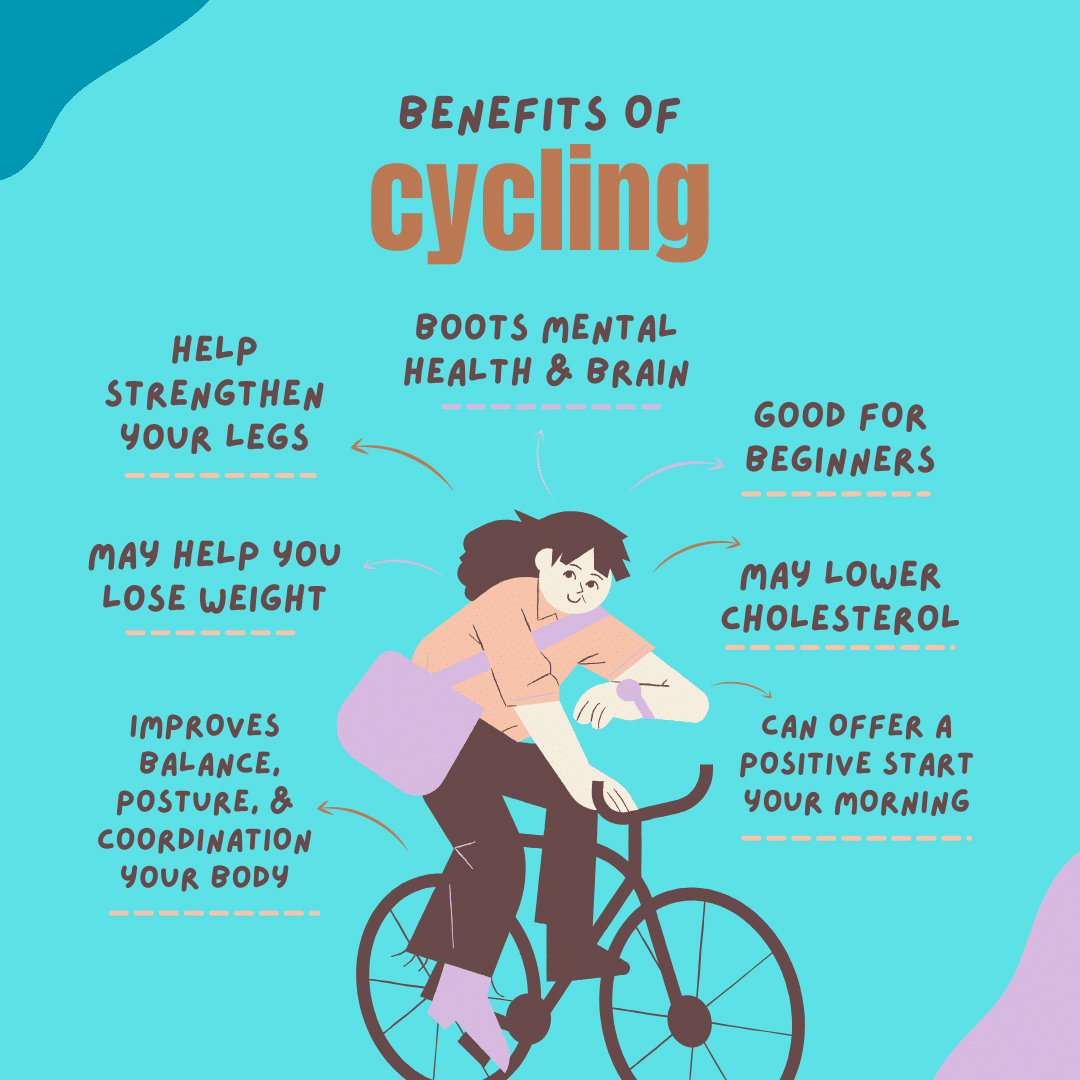Cycling isn’t just a mode of transport, it’s a portal to a healthier, happier you! Buckle up for 30 unmissable benefits of cycling everyday that’ll have you ditching the car keys and rediscovering the open road – and the open sky, and the wind in your hair.
Remember that grumpy co-worker who traded their car for a commute on two wheels? Now they’re a ray of sunshine, radiating endorphins and sporting those enviable quads. That’s because cycling is a double whammy for your well-being. It pumps up your heart rate, boosting your cardio fitness and slashing the risk of nasty diseases like heart attacks and stroke. Plus, the fresh air and scenery work their magic on your mood, banishing stress and leaving you feeling zen-like.
So, what are you waiting for? Dust off that old bike, pump up those tires, and prepare to be amazed. Cycling isn’t just good for your legs, it’s good for your heart, your lungs, your soul, and even the planet. It’s a win-win on two wheels. Ready to join the revolution? Let’s ride!
Content Highlights
- Cycling delivers extensive whole-body physical and mental health benefits.
- Riding a bike supports weight loss, muscle gain, brain boosts, and much more.
- Integrate cycling into your lifestyle for superior fitness and wellness payoffs.
- Nearly any age or fitness level can achieve gains through routine riding.
- Prioritize pedaling your way to better health and happiness now!
Benefits of Cycling: At a Glance
Check out the following table to learn briefly about the benefits of cycling.
|
Benefit |
Description |
|
1. Enhances heart health |
Cycling strengthens the heart muscle, promotes cardiac function, and reduces heart disease risk by 50%. |
|
2. Burns major calories |
Cycling torches up to 600 calories per hour, supporting weight loss and metabolism. |
|
3. Strengthens lower body |
Pedaling builds leg, glute, and calf muscle power. |
|
4. Enhances upper body tone |
Tension while steering works the arms, shoulders, chest, and back. |
|
5. Elevates endurance |
Biking conditions cardiorespiratory fitness for performing at higher intensities in any activity. |
|
6. Maximizes flexibility |
Fluid pedal strokes combined with riding positions improve joint and muscle flexibility. |
|
7. Refines coordination |
Mastering a bicycle sharpens balance, spatial awareness, reactions, and total body coordination. |
|
8. Lessens anxiety/depression |
Cycling boosts mood while reducing anxiety and depression. |
|
9. Boosts mental health |
Riding a bike combats stress and cultivates positive thinking patterns. |
|
10. Expands brain power |
Cycling grows new neurons and gray matter in regions linked to memory, focus, and cognition. |
|
11. Lowers dementia odds |
Reduced cognitive decline risk comes from cycling’s brain tissue proliferation. |
|
12. Lessens chronic disease |
Moderate activity like cycling curbs inflammation that causes diabetes, heart disease, and more. |
|
13. Requires no equipment |
Just a bike enables cycling with minimal costs and storage needs. |
|
14. Fits all fitness levels |
Riders can cycle at intensities suiting current ability from rehabilitation to fierce training. |
|
15. Offers fun and freedom |
From joyful momentum to adventures to accomplishments, cycling entertains across settings. |
|
16. Suitable for beginners |
Cycling provides health benefits for all fitness levels with low barriers to entry. |
|
17. Helps individuals with cancer |
Appropriate cycling aids cancer patients, fitness, recovery, and quality of life. |
|
18. Gives a positive morning start |
Early fasting rides energize metabolism and moods. |
|
19. Is environmentally-friendly |
Bike commuting radically decreases individual carbon emissions from transport. |
|
20. Helps diabetes prevention |
Making time for half-hour bike rides substantially lowers diabetes risk. |
|
21. Supports bone/joint health |
Cycling is ideal for joint conditions, coordination, balance, and fracture rehabilitation. |
|
22. Offers hand cycling adaptation |
Hand cycles build strength for spinal cord injuries, stroke recovery, and upper body disabilities. |
|
23. Promotes longevity |
Frequent short cycling sessions make the body more biologically youthful and disease-resilient. |
|
24. Supports the gut |
Aerobic stimulation while riding prevents digestive issues and diseases. |
|
25. Lowers carbon footprint |
Cycling dramatically shrinks transit resource use, pollution, and congestion at scale. |
|
26. Supports pregnancy |
Biking while expecting aids fitness and emotional health for mothers and babies. |
|
27. Helps sexual function |
Cycling sustains reproductive health and sexuality throughout the lifespan. |
|
28. Boosts general athletics |
Cross-training cycling builds capabilities like strength, speed, and endurance for specialized sports. |
|
29. Fosters family bonds |
Kids riding along promotes modeling healthy habits; grandparents can join too. |
|
30. Regulates sleep |
Exertion and cortisol regulation from riding realign circadian cycles. |
Benefits of cycling Everyday
Riding a bicycle engages muscles throughout your body, from strengthened legs churning the pedals to abs and arms steering. This total body fitness not only fuels cardiovascular health but also improves strength, endurance, flexibility, coordination, balance, posture, and more. Beyond the physical, cycling also does wonders for mental health, cognitive function, and emotional wellbeing.
This low-impact activity accommodates nearly all ages and fitness levels, from young children first learning to balance to elderly individuals requiring gentle joint movements. Recreational rides, cycling workouts, or bike commuting all let you reap the plethora of science-backed benefits.
Ready to uncover all the ways bicycles can transform your health and happiness? Keep reading for 30 incredible payoffs awaiting you on two wheels!
30 Phenomenal Benefits of Cycling
In this section, we’ll thoroughly discuss the 30 benefits of cycling. So keep reading and grasping all the details.
1. Enhances heart health
The heart is a muscle that grows stronger through exercise. Since cycling raises your heart rate for extended periods, it promotes cardiac health. Just 30 minutes of cycling three to four times a week has been found to reduce the risk of heart disease by 50% (1). Routine riding keeps this vital organ in shape to pump blood efficiently.
2. Burns major calories
Cycling torches up to 600 calories per hour, making it an extremely effective calorie-blasting exercise (2). The faster and longer you ride, the more energy gets used up. This makes bicycles a key tool for managing weight, boosting metabolism, and supporting fat loss.
3. Strengthens the lower body
Churning the pedals builds considerable strength in leg, glute, and calf muscles. Cyclists develop increased power, allowing them to bike faster and longer. These fitness gains transfer off the bike too, through improved daily function, athletic performance, injury resilience, and longevity.
4. Enhances upper body tone
Though not as extreme as legs, arms, shoulders, chest, and backs also derive strength benefits from cycling. Tension while steering works the upper body. Adding push-ups, planks, or weightlifting provides whole-body results. This improved functional fitness assists in daily life.
5. Elevates endurance
As cardiorespiratory systems become conditioned over time, cyclists can ride harder for longer durations without tiring. Oxygen circulates easier, fueling sustained effort. These boosts in muscular and cardiovascular endurance aid any activity requiring prolonged exertion.
6. Maximizes Flexibility
The broad range of motion utilized while pedaling as well as stretching positioning enhances joint suppleness and flexibility, especially around the hips and hamstrings. Increased movement fluidity reduces injury risks associated with poor mobility. This flexibility transfers into other fitness domains and daily life.
7. Refines coordination and reflexes
Mastering a bicycle involves developing phenomenal balance, reaction times, spatial awareness, and limb coordination. Nervous systems sharpen to nimbly handle unpredictable conditions like traffic, terrain changes, or weather. These neurological gains bring the body and mind into greater sync.
8. Lessens Anxiety and Depression
Research finds aerobic exercise cycling significantly reduces anxiety sensitivity scores while elevating mood and emotional states (3). The sport’s social satisfaction, health gains, and accomplished goal-setting further combat issues like stress, depression, and poor self-image.
9. Boosts mental health
[Video Credits @Fitnessdy]
In addition to minimizing anxiety and depression, cycling also enhances overall mental health and outlook. Brain chemicals and pathways associated with positivity fire more due to flowing blood and oxygen. Just thinking more clearly curbs mood disorders. These cognitive gains fight mental illness risks.
10. Expands brain power
Studies demonstrate cyclists have increased hippocampal tissue volume compared to non-riders, allowing better memory formation and recall (4). Pedaling pace challenges cerebellar function, multiplying neurons. These neural effects amplify learning capacity, focus, multitasking skills, and creativity.
11. Lowers Dementia Odds
Because cycling grows gray matter while flushing waste accumulation linked to cognitive decline, consistent riding reduces dementia risks by a whopping 40% versus non-riders (5). Strong minds resist memory loss, confusion, attention deficits, and impaired reasoning faculties.
12. Lessens chronic disease
Regular activity stimulates immune defenses against systemic inflammation underlying diabetes, obesity, respiratory conditions, heart disease, and the like. Just 30 to 60 minutes of cycling three to four times a week minimizes numerous chronic and terminal illness likelihoods.
13. Requires No Equipment
Unlike sports demanding clubs, fields, nets, or gear, cycling necessitates just a bike and helmet—easily available items even on tight budgets. Minimal costs and storage needs allow access, despite busy lifestyles or small living spaces. Greater convenience promotes routine participation.
14. Fits All Fitness Levels
Cycling accommodates nearly every age and athletic ability, adjusting intensity to appropriately challenge yet not overwhelm current capacities. Low resistance builds confidence in deconditioned or disabled populations. Competitors drive progress through interval, hill, or sprint training. Such broad appeal allows lifetime engagement.
15. Offers Fun and Freedom
Gliding effortlessly using your body’s momentum simply feels joyful! Peaceful nature rides, adrenaline-pumping terrain, or social group outings provide entertainment hard to replicate elsewhere. Cycling adventures remain close yet open new worlds. Achieving distance goals grants immense satisfaction.
16. Suitable for Beginners
Riding a bicycle is fairly easy to learn. Stationary bicycles offer an accessible alternative for those unable to ride a standard bike. Cycling provides health benefits for all fitness levels. Beginners can start slow at lower intensities, then increase intensity over time as fitness improves.
Even short or occasional cycling sessions for previously inactive people lead to health gains. In summary, cycling is adaptable for people new to working out. It serves as a gentle, low-impact activity to become more active.
17. It Can Help Individuals with Cancer
Cycling can benefit cancer patients, though some may lack energy or have pain during treatment. Check with your medical team first, and only exercise as much as possible. Cycling helps cancer survivors stay lean and active, potentially reducing recurrence risk for some cancers, like breast cancer.
Recent research shows breast cancer patients who cycle manage side effects like fatigue better and report improved quality of life. In moderation, cycling empowers patients to move comfortably during cancer care. When given the go-ahead by doctors, it promotes recovery and long-term wellness.
18. It Can Give You a Positive Start in the Morning
Starting your day by cycling gently boosts circulation and mood. Early activity establishes a sense of achievement. Studies show morning rides, especially shorter fasted sessions, help casual riders burn fat and energize their metabolism. However, athletes require fuel for intensive training.
So while the average person benefits from brisk, early rides without eating first, competitive cyclists need nutrition ahead of long endurance workouts. In moderation, morning cycling before eating provides perks like fat burn, vitality, and an upbeat mindset throughout the day.
19. It is Environment-friendly
Choosing to bike over drive slashes individual carbon emissions from transport. A European study calculated that commuting daily by bicycle rather than car cuts a person’s carbon footprint by 67% from travel. Cycling replaces polluting rides stuck in traffic. It works better than walking to mid-range destinations and skips parking hunts.
With less congestion and emissions, cycling also improves air quality. Pedaling moderately benefits the planet across populations. If more people opted to cycle for feasible trips, it would ease gridlock and dramatically lower vehicle outputs. Biking enables greener commutes for better environmental health at scale.
20. Cycling Can Help in Diabetes
Rates of type 2 diabetes continue to rise alarmingly, spurring public health action. Physical inactivity contributes heavily to the development of diabetes. A sizable Finland study discovered bicycling over 30 minutes daily substantially prevents diabetes. When compared to non-active peers, those who consistently cycled had a 40% lower diabetes risk.
Simply exercising by bike appears protective, even without other lifestyle modifications. Making time for half-hour bike rides enables the average adult to slash the odds of acquiring this prevalent, serious condition. Regular cycling emerges as an accessible, sustainable diabetes deterrent across populations. Integrating short, frequent bike sessions empowers people to curb their chances without medication or clinics through movement alone.
21. Arthritis, Bone Injuries, and Cycling
Cycling enhances strength, balance, and coordination—useful in injury prevention. Bike riding supports joint health, making it ideal for people with osteoarthritis. The activity does not directly combat osteoporosis, however. Cycling lacks the weight-bearing elements needed to stimulate bone density. But the cardio workout improves function after fractures.
Cycling’s low-impact nature prevents further joint damage, which is important for arthritis. The activity aids equilibrium and control too, minimizing fall risk. So while biking fails to address underlying bone loss, it safely restores mobility after breaks. The exercise constitutes gentle joint and fracture rehab for those requiring it. Overall, cycling promotes joint protection and renewed coordination during recovery.
22. Hand Cycling and Health
Hand cycles operate like recumbent tricycles but use upper-body power. If necessary, Velcro straps help riders propel the pedals with their hands. This adaptive model accommodates various disabilities, enabling diverse populations to access cycling. Hand cycles permit amputees, spinal injury survivors, stroke patients, and others with limited mobility to bike for fun and fitness.
Upper-body aerobic activity yields cardiovascular perks comparable to traditional cycling. Overall, hand-powered tricycles uniquely include people who cannot use standard bicycles while providing equivalent workout gains. The accessible, inclusive equipment restores cherished recreation and effective cardio training for injured athletes or those managing chronic conditions.
23. Live Longer
A King’s College London twin study discovered cycling dramatically slows aging. Comparing over 2,400 identical twins revealed that riding just 3×45 minutes weekly makes bodies 9 years “biologically younger.” This held even after balancing other influences like BMI and smoking. Lead researcher Dr. Lynn Cherkas explains that exercise, and cycling specifically, substantially lowers age-related disease risks through improved cell regeneration and immunity.
Greater efficiency in regenerating fresh cells and defending against threats keeps frequent rihealthier for longer. So while genes play a key role, routine cycling allows the body to maximize its innate protection, repair, and renewal systems. In this way, regular short bike sessions reverse aging’s effects to prolong wellbeing and vitality.
24. Supports Your Gut
Research from the University of Bristol shows cycling improves digestive and colorectal health. Faster intestinal transit while riding allows less water reabsorption, producing easier bowel movements, according to Dr. Raimundo. The aerobic activity also quickens breathing and heart rate. This stimulation contracts intestinal muscles more often to relieve bloating, per the gastroenterologist.
Experts advise that these mechanisms safeguard against bowel inflammation and cancer over time. So beyond general fitness gains, cycling’s abdominal effects prevent digestive issues. Combining physical activation with reduced gut transit time, the exercise empties the intestines while preventing infection and disease. Through modifiable lifestyle factors alone, routine cycling promotes better gastrointestinal function, protecting long-term wellness.
25. Lowers Carbon Footprint
Bicycles dramatically outperform cars as sustainable transit. Per area used, 20 bikes park where only 1 car fits. Producing a bike also requires just 5% of the materials and energy needed for automobiles. Pedal power emits zero pollution, unlike vehicles. Measuring transport efficiency, cycling travels nearly three times faster than walking for matched human energy.
Factoring nutritional “fuel” burned, bikes average an impressive 2,924 miles per gallon—far surpassing cars. This stems from extreme weight differences: riders weigh about 6 times more than their bicycles, whereas cars outweigh humans by a factor of 20. So replacing driving with cycling radically shrinks material demands, emissions, and space required. Due to simple physics enabling huge mileage per watt, biking revolutionizes the sustainability of short-distance transportation.
26. Supports Pregnancy
Biking while expecting carries advantages for fit moms and babies when practiced safely. A Michigan University study discovered expectant mothers exercising regularly, including cycling, experienced fewer labor complications and quicker recovery. They also maintained better moods throughout pregnancy. Royal College spokesperson Patrick O’Brien reinforces that moderate activity like biking helps keep mothers and developing fetuses healthy.
Conditioning from the cardio limits labor risks and emotional issues before and after childbirth. The gentle activity likewise lets mothers-to-be retain physical outlets and mobility even with a growing baby. So doctors increasingly recommend pregnant women stay active via protected forms of exercise, with cycling providing a popular and safe means for continued wellbeing.
27. Better Sex Life
Cycling and other regular exercises uphold sexuality across genders and ages. Physical activity strengthens blood flow, energizing arousal,per US experts. Cornell research further links male athleticism to higher sexual prowess, equivalent to a 2–5-year age reduction. Staying active also delays menopause similarly, which can diminish libido if done early.
Post-menopause cycling helps too, with over 50s riding over 3 hours weekly, lowering impotence risk by 30% (Harvard). Building cardiovascular health simultaneously sustains reproductive function and long-term interest. Both fitness-enabled circulation and delayed hormonal transitions preserve sexual vitality over decades. So cycling constitutes accessible, lasting bedrock for relationships—protecting intimacy and pleasure via simple lifestyle factors.
28. It’s Good for Several Sports
Cycling delivers versatile conditioning to amplify overall capabilities. A Norwegian study conclusively found aerobic endurance training via cycling drastically elevates soccer play. This demonstrates the cross-disciplining effects of sports relying on cardio capacity. Alongside general fitness gains, riding a bike before tennis will lift weekly match play as well.
Whether training to hone an edge professionally or uphold recreational enjoyment, incorporating bike sessions builds key athletic traits. Dedicating time to cycling advances stamina, quickness, coordination, muscle tone, and recovery. So versatile bike training primes sought-after traits to then apply directly within specialized sports for personal goals, from competitive ranking to weekly matches with friends.
29. It’s a Suitable Family Time
Cycling brings generations together through shared activity. Even toddlers can ride along in bike seats or tow trailers as parents pedal. Research confirms children mirror the active lifestyle choices modeled by parents. So regular family rides establish lifelong healthy habits early. Besides influencing youth activity levels, cycling accommodates aging mobility with appropriate bike options.
This enables grandparents to join in on three-generation outings as well. Taking up cycling as a family thus engages kids and older adults simultaneously with low-impact, socially-bonding exercise. Bypassing age or ability barriers through inclusive equipment, bikes allow relatable recreation spanning the ages. Consistent time spent riding outside can cultivate family ties along with physical health across lifespans.
30. Good for Sleep
Cycling helps regulate the sleep cycles disrupted by modern life. Losing an hour of sleep a night can raise cortisol, further depriving us of rest. Riding counters hormones and patterns that prevent quality rest. Pedaling away cortisol while exerting energy realigns the body for renewed sleep regulation. In turn, sufficient sleep enhances workout recovery and progress.
So not only is cycling itself great training, but its biological balancing effects optimize fitness gains long-term. Adults short on sleep and exercise can achieve substantial wellbeing improvements by adopting regular bike riding. Simply integrating consistent sessions supports natural sleep-wake homeostasis related to training demands. The easy habit allows fitting activity around life while combating a prevalent health issue.
Takeaway: Integrate Cycling for Whole-body Wellness
The extensive physical and mental health benefits of cycling prove riding a bike delivers profoundly more than merely getting from point A to point B. Integrating bike-based activity fosters considerable whole-body wellness advantages.
Hopping onto a bicycle seats you inside your very own gym, strengthening cardiovascular, muscular, and mental fitness in enjoyable ways well within most people’s physical abilities. Yet despite its universality, cycling manages to also provide sufficient challenges that professional athletes appreciate too.
So whether you currently struggle to get motivated to exercise, train competitively, or simply wish to amplify your current fitness outcomes, substituting cycling into your regimen launches transformative results. Pedal your way to boosted health and happiness now!
Frequently Asked Questions (FAQs)
Check out the following questions and answers if you have more queries about the benefits of cycling.
What does cycling do for your body?
Cycling strengthens the cardiovascular system, burns calories for weight control, builds substantial lower body strength, enhances upper body tone, elevates endurance for sustained activity, maximizes joint flexibility and range of motion, refines whole-body coordination, balance, and reflexes, and lowers the risks of chronic illnesses like heart disease. Read the article above to learn about the benefits of cycling in detail.
How often should you cycle for health benefits?
Experts recommend cycling for 30–60 minutes at least three days a week to start garnering substantial fitness and mental health gains. Even shorter or less frequent riding offers advantages, but aiming for an hour of riding four days a week provides transformative whole-body wellness boosts.
At what age can you start cycling?
Toddlers as young as 18 months old can begin riding tricycles, then graduate to balance bikes around ages 2–3 before transitioning to pedal bicycles around ages 4–6 once they have achieved sufficient balance and coordination milestones. Cycling remains appropriate for all ages, just tailoring bike types and riding intensity levels to current developmental stages.
Is 30 minutes of cycling enough?
While longer rides are ideal, even just 30 minutes of cycling three days a week elevates heart health, burns extra calories, engages the core and legs, and enhances mental well-being. Short daily commutes quickly accumulate weekly minutes. High-intensity 30-minute interval training sessions maximize limited timeframes too. Any cycling beats none!










































